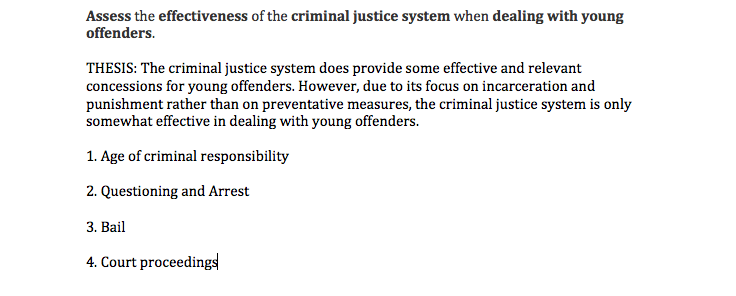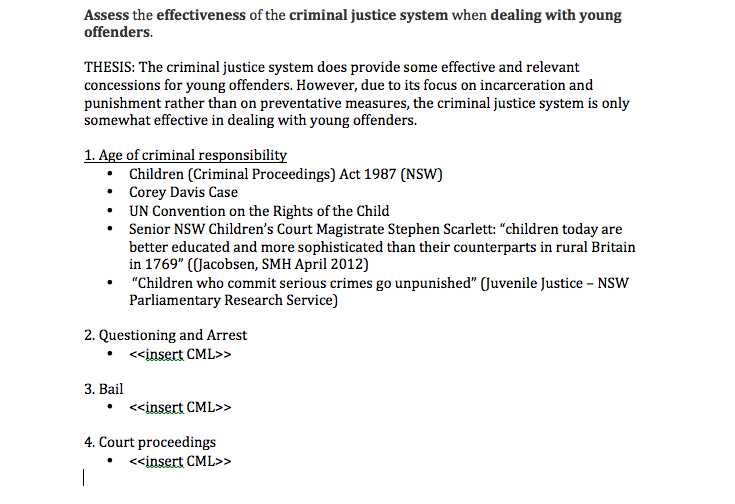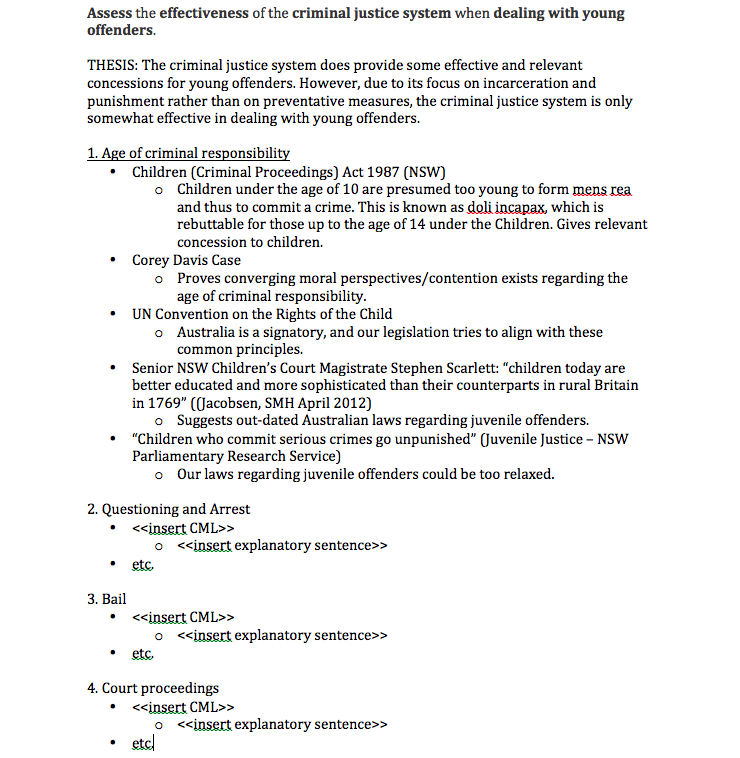Got an essay for Legal Studies due soon, but are a little unsure about how to write it? Or perhaps you’re looking for a Legal Studies essay scaffold so you’ve got a structure for your info?
Don’t worry, we’ve got your back! It’s not as hard as you might think — all it takes is 5 steps, which we’ll be walking you through in this article.
Ready to get started? Let’s go!
Scaffolding
Step 1: Analyse the question
Step 2: Come up with a thesis
Step 3: Structure your argument
Step 4: Insert cases, media and legislation
Step 5: Explain cases, media and legislation
Scaffolding – How to Write a Legal Studies Essay Using an Essay Skeleton
In HSC Legal Studies, scaffolding (aka “writing an essay skeleton“) is a quick way to draft the most important points of an HSC Legal Studies essay into an easy to remember structure!
Because it means you can write, technically, several essay scaffolds in the time you would usually take to write one full essay!
This means you are revising much more content in a shorter amount of time which is a great way to practice content for Legal Studies!
To explain how you can use a Legal Studies essay scaffold, we’ll be using the following question from the Core: Crime. But you can apply this any way to your own electives!
We will work through this question together using our 5 simple steps:
Assess the effectiveness of the criminal justice system when dealing with young offenders.
So without further delay, how do you start a legal studies essay?
Step 1: Analyse the question
“What are the buzzwords in the question?”
The first thing we need to do is highlight the buzzwords in the question (which you’ve written at the top of your scaffold). So below, we have bolded these.
Assess the effectiveness of the criminal justice system when dealing with young offenders.
These are the key points you will be assessed in. You need to be:
- Assessing: evaluating how good or bad something is
- The effectiveness: how efficient
- The criminal justice system is: the law (government legislation, courts, police, etc.)
- When dealing with young offenders: the legal processes a young offender will come into contact with
Therefore, your essay will need to be an evaluation of the way the law handles young offenders, and will need to have a stance on whether or not this is efficient, or a detrimental/slow/backwards journey.
Looking to the syllabus, we know this information is under “5. Young Offenders”. Which are the following points:
- Age of criminal responsibility
- The rights of children when questioned or arrested
- Children’s Court
- Penalties for children
- Alternatives to court
Preparing for your Legal exam with one day to go? Read through our guide to preparing for your HSC Legal Studies exam the night before!
Step 2: Come up with a thesis
“What is your personal response to the question?”
So given that we will be talking about those 5 syllabus points from above, which you should by now have a firm grasp of, you should be able to answer: How would you describe the way the law deals with young offenders?
There is not one correct answer. You will be marked on how you argue your point of view.
For the sake of this example, we will use one possible thesis:
The criminal justice system does provide some effective and relevant concessions for young offenders. However, due to its focus on incarceration and punishment rather than on preventative measures, the criminal justice system is only somewhat effective in dealing with young offenders.
This should be written at your top of your Legal Studies essay scaffold, under thesis.
Step 3: Structure your argument
“How will you structure the body of your essay so that you can prove your thesis?”
This means organising your ideas into themes. Usually, in Crime, you should be tackling 3-5 of these “themes”.
For example, this question could be organised as such:
- Age of criminal responsibility
- Questioning and Arrest
- Bail
- Court proceedings
These are 4 major ways in which the criminal justice system deals with young offenders. There are many variations, but this one works ‘linearly’, as it is the process a juvenile offender would face.
Each of these act as the theme of a paragraph (or two!) under which you will place information and your explanations.
Step 4: Insert cases, media and legislation
“What Cases, Media, and Legislation (C.M.L) do I have that support my argument?”
It is time to insert all the content and information you have been learning into your Legal Studies essay scaffold.
This is when you should read through all the information you have on the syllabus points we identified previously, in order to back up your point of view.
You should briefly dot-point in the citations for that CML you have, and the quote or piece of information.
This is a scaffold, so it does not need to be a full citation. For example, for the first paragraph/theme we found, it would be as follows:
1. Age of criminal responsibility
- Children (Criminal Proceedings) Act 1987 (NSW)
- Corey Davis Case
- UN Convention on the Rights of the Child
- Senior NSW Children’s Court Magistrate Stephen Scarlett: “children today are better educated and more sophisticated than their counterparts in rural Britain in 1769” ((Jacobsen, SMH April 2012)
- “Children who commit serious crimes go unpunished” (Juvenile Justice – NSW Parliamentary Research Service)
These will serve as the basis for each paragraph, or idea that you write about. Remember, this is a scaffold, so it’s about organising content and writing a skeleton for your essay.
Step 5: Explain cases, media and legislation
“How do I explain why these Cases, Media and Legislation are relevant to my argument?”
Under each dot point, it is good to include a short sentence which explains why you’ve included that piece of CML. This isn’t usually required in essay skeletons and many people leave it out, but for me, it’s the most important part.
Looking for the right crime cases? We’ve completed a list on the essential crime cases you will need for HSC Legal Studies!
Why?
Because just throwing in CML won’t give you marks. It’s all about using your own mind to create an argument. HSC markers look for this. So these little sentences are the ‘meat’ of your scaffold!
Sure, you could leave them out. But that, for me, is an incomplete scaffold.
So this is what I like to end up with:
1. Age of criminal responsibility
- Children (Criminal Proceedings) Act 1987 (NSW)
- Children under the age of 10 are presumed too young to form mens rea and thus to commit a crime. This is known as doli incapax, which is rebuttable for those up to the age of 14 under the Children. Gives relevant concession to children.
- Corey Davis Case
- Proves converging moral perspectives/contention exists regarding the age of criminal responsibility.
- UN Convention on the Rights of the Child
- Australia is a signatory, and our legislation tries to align with these common principles.
- Senior NSW Children’s Court Magistrate Stephen Scarlett: “children today are better educated and more sophisticated than their counterparts in rural Britain in 1769” ((Jacobsen, SMH April 2012)
- Suggests out-dated Australian laws regarding juvenile offenders.
- “Children who commit serious crimes go unpunished” (Juvenile Justice – NSW Parliamentary Research Service)
- Our laws regarding juvenile offenders could be too relaxed.
So in full, your finished Legal Studies essay scaffold should look something like this…
Now that we’ve walked you through how to write up your Legal Studies essay scaffold, it’ll be much simpler writing up the actual essay. Good luck!
Preparing for your Business Studies exam too? Check out our guide to writing a Band 6 Business Studies report!
Looking for some extra help with how to write a HSC Legal Studies essay?
We pride ourselves on our inspirational HSC Legal Studies coaches and mentors!
We offer tutoring and mentoring for Years K-12 in a variety of subjects, with personalised lessons conducted one-on-one in your home or at one of our state of the art campuses in Hornsby or the Hills!
To find out more and get started with an inspirational tutor and mentor get in touch today!
Give us a ring on 1300 267 888, email us at [email protected] or check us out on TikTok!
Sophia Zou completed the HSC in 2013, so fortunately for AOS Community Blog-readers and perhaps less fortunately for her, the memories of Year 12 are still fresh in her head. Sophia considers it her mission here to help students make the most of their final years at high school. Her interests include political science, Simon and Garfunkel, and pretending to be a tea aficionado. Alongside tutoring at Art of Smart Education, she spends her time playing the piano and studying Government & IR and Languages at the University of Sydney.











